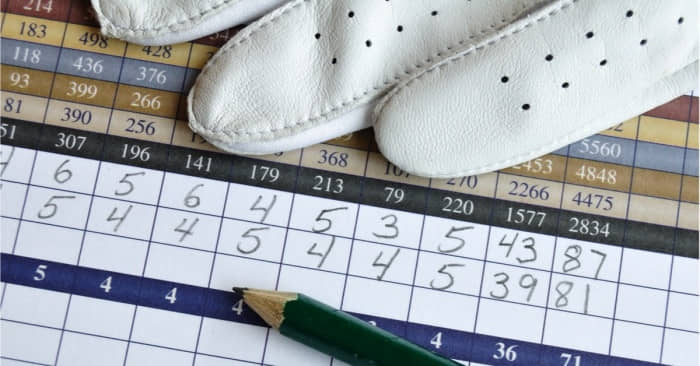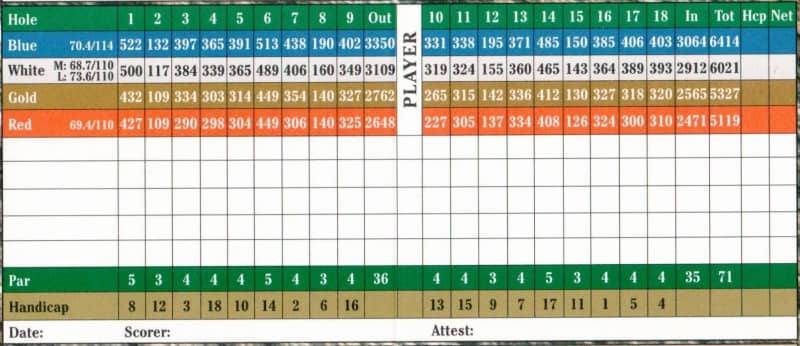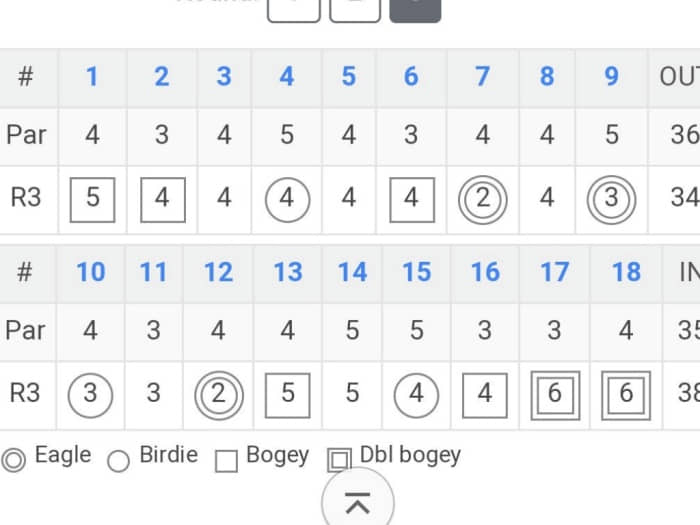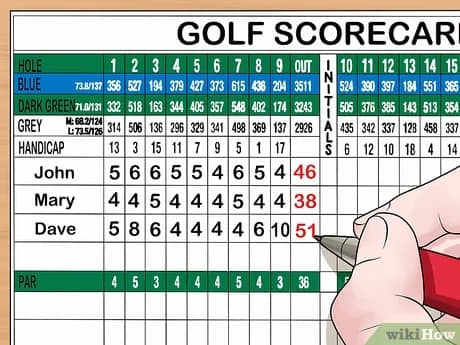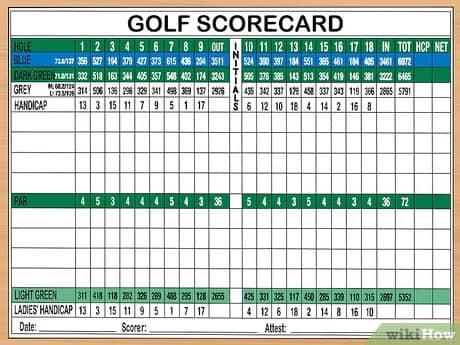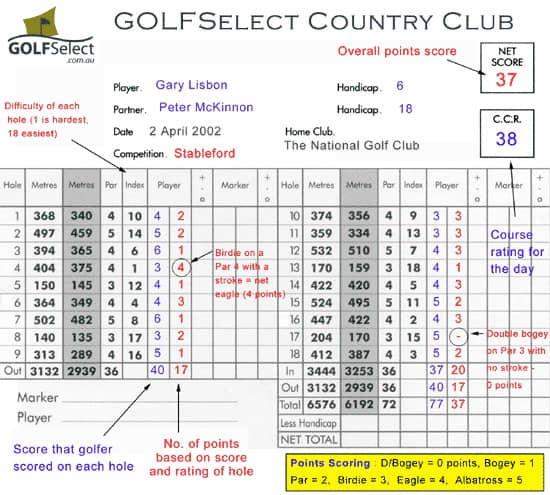Golf has always been considered a high-end sport for the “elite” people for its significantly high cost.
Everything in golf, from practice sportswear to golf clubs, takes quite much money to afford.
With such a high-fashion vibe like that, golf requires a lot of rules and discipline to follow, either.
For example, the golf scorecard contains many special symbols and holes; and each data refers to an element in a golf round.
It is undeniable that reading the scorecard is quite challenging for new golfers. In this golf scorecard explained, let’s learn how to read this special golf equipment.
What Is A Golf Scorecard?
To begin with, we should first take a look at what a golf scorecard is. In short, it is a tool, a paper to record all scores that happened during the golf course.
With the golf scorecard, it is easier and more consistent to keep track of a golf round.
The golf scorecard is widely used in the professional world and amateur playing.
The rules for making a golf scorecard are accepted worldwide, so you only need to learn about the rules once and play in any country, in any championship in the world.
One of the first things you will experience when practicing golf is learning how to read scorecards.
Undoubtedly, using the scorecard to keep track of your performance is a good habit of seeing how much you improve through time.
The typical layout of a scorecard is 6 inches in length and 4.5 inches in width.
There are about 18 columns, representing 198 holes, and rows for par, handicap, and color names. We will analyze these elements in the later section.
Golf Scorecard – What Do The Symbols Represent?
On a scorecard, besides the columns and rows that refer to “holes,” we also have different symbols to represent different golf scores.
For instance, if you see the solid circle symbol, this emblem mentions an “Eagle” or better scores as Albatross, or hole in one.
For further information, Albatross means “three under par” but can also be used interchangeably to “double eagle” because the case of getting three under par in golf is quite rare.
Besides, if the circle is quite thin, don’t misunderstand it with the “Eagles” sign. The light circle symbol refers to a Birdie.
This term refers to “a score of one under par” and originates from the American slang “bird,” meaning cool or excellent.
What about the square symbol? This square emblem will provoke you about a Bogey score. Originated from Scottish slang, the term Bogey represents “one over par”.
When the square sign is thick and solid, that is definitely a sign for Double-bogey or worse scores. Finally, if there is a symbol, you can understand that it is par.
It would be best to learn the meaning of these symbols since it will take you less time to scan the scorecard and note your performance.
Golf Scorecard Explained – How to Read a Scorecard? (Best Tips)
Find The “Hole” Column
First, let’s take a look at the golf scorecard. You can see that there are 18 columns, labeled from 1 to 18, right?
These columns symbolize the holes on the golf court. So, the first thing is to get used to the numbering system.
Typically, the card will be divided into two sections with nine holes each. The 1-9 holes are called “front 9”, while the 11-18 holes are “back 9”.
There is an “OUT” symbol next to column 9, which means playing away from the clubhouse.
Meanwhile, next to the 18th column is an “IN” sign, which means playing back towards the clubhouse.
Many case scenarios happen: players start playing at the first hole, then complete to the 18 holes. There are cases where players finish all 18 holes and come back to the 1st one.
Why do you need to learn this information? Because these holes are where you will note the score of your teammate, or even yourself later.
Identify The Color-code And Handicap Section
You can immediately identify different color names on both top and bottom of the card. So, what do they mean? In fact, these colors symbolize the tee boxes on each hole.
Typically, beside each color name and under the hole number is a small figure, representing the distance of that hole.
From the tee you stand, the meaning of that statistics can be changed to add-in.
When arriving at each hole, the tee will be symbolized by a relevant color name, and you will base on this information to insert your score into the card.
There are black, gold, blue, white, red, and green tees. To be specific, black and gold tees are chosen by professionals or expert-level amateur golfers.
What about white tees? They are called “middle tees” as it is popular for intermediate golfer.
Blue tees share the same feature, but, relatively, the standard for blue tees are higher than white one and nearly reach the black tees.
Meanwhile, red tees are the options for short players with limited approaches. Green tees are for entry-level players.
There is a “handicap” row in the middle of the card that ranks the difficulty level between the holes.
Spot The “Par” Row
Under the color names, above the “handicap” is the “par” row. Looking at the par section, you will see a string of numbers.
What are they about? They are recommended scores that you should take in each hole.
In golf scorecards, par means “number of strokes on a hole.” If you don’t know which achievement is good enough, take the par information as a reference.
Suppose you start practicing golf and need a “standard” score as a goal to reach, then you can consider the par score as a suggestion.
Usually, the par score is not too high or low, but “so-so” and suitable for elementary players, so don’t worry that the par is too much to reach.
To add-in, the total par score is 72, with the most common number is 3 and 4. If you can reach all par scores for all holes, then your score must be 72 or varies from 70 to 80.
Take Note All Net Scores
Now that you have already finished three pre-record steps. Let’s start “real” noting the score.
We suggest playing with a maximum of three people for each golf round since two partners can create a “bias” case, but four partners start taking a long time to wait for each other and take note.
Additionally, there should be only one person to record the score. It could be better if he/she just comes over to take a look, not play, to make their record more reliable.
The process of score noting will go on as a typical marking procedure in schools.
At the end of the round, calculate the summary score, find the difference between the par and that player’s score.
What’s next? You mark the difference with the real score. The final result is the summary of the “difference” and the real score after golfing.
If you score exactly like the par, then the marker will note that the gap is an “E”.
For instance, if the par is 40, and your score is 50, then the gap “10” will be added to the final result. So, your final score is 60.
Suppose the par is 20, and you score exactly 20, then your final mark is 20 plus E, which means 20.
But the marking process doesn’t end here. You have to add the handicap score to add-in. Let us provide an example for you for better understanding.
Suppose you are scoring on the hole with a ten-score handicap.
It takes you 80 shots to complete the par 700, so you have to minus 10 to the 80 scores, and what you have – 70 – is the final score.
With this performance, you have just achieved the par.
Typically, the more professional a player is, the lower handicap they have and vice versa.
This fact is easy to understand since the handicap point is such a big support for new players to reach the “par” score.
However, the professionals don’t want that support. They demand their scores as “real” and near the standard as possible.
The higher the handicap is, the less accurate your punch is.
So, if you want to play amateur, there is no need to worry about the handicap. But in case you intend to go professionally, then try to lower the handicap score as much as possible.
Wrapping It Up
The above article is our in-depth golf scorecard explained. In short, there are four steps when reading a golf scorecard, and the most important one is the final – note-taking.
Please pay more attention to this step.
We believe that this guide provides you with useful insights when playing golf. Good luck with your battle!

